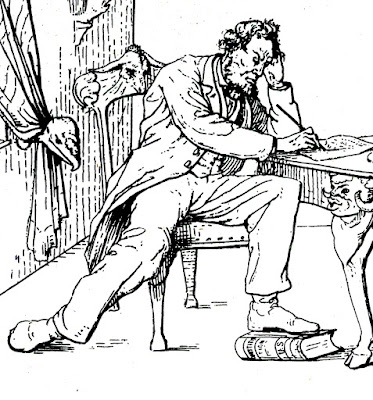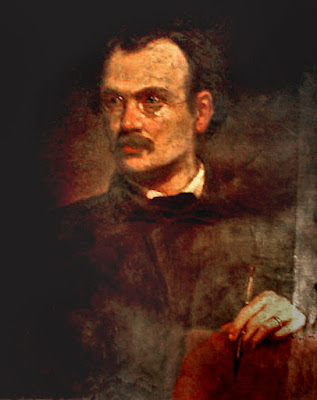Writing the Emancipation Proclamation.
This c. 1864 etching by Baltimore dentist Adelbert J. Volck entitled Writing the Emancipation Proclamation was produced during the civil war and published in collection of such caricatures by V. Blada. Blada says of this one:
... the writing of the Proclamation of Emancipation. Of course President Lincoln was, in the view of those in the control of the seceded states, trampling the Constitution of the United States under his feet. The secessionists never got over the theory, even in the midst of their efforts to overthrow the government, that they were in a special degree the appointed interpreters and authorized defenders of the Constitution. It was a natural and popular stroke therefore for the artist to place the Constitution under the feet of the President who was seeking to enforce the laws and save the Union. The idea that the Union and the Constitution could be preserved by force of arms in a war that throughout the Confederacy was popularly called “the John Brown raid on a large scale” was regarded as the most preposterous proposition that had ever been heard of. Negroes heads with rams horns decorate the table upon which Lincoln writes the proclamation of freedom, and the legs end with Satanic cloven feet. Upon the wall is a picture showing the massacres of St. Domingo, the murder of children and the desolation of homes. John Brown, with a palm in one hand and a pike in the other, looks with cranky benignity from a frame. The Statue of Liberty is burlesqued with a baboons head and a laurel wreath suggesting the favorite revilement of Lincoln as a gorilla. The devil holds his inkstand and on the back of his chair is an ass’s head! This gives at a stroke the Southern notion of the war and the purport of the Proclamation at the time it was issued. The war as the Southern people saw it, was on the part of the national authorities the massacre of white men in a fanatical crusade for the blacks. It was as they believed wholly prohibited by the Constitution, and they understood the invasion of the territory they held to be their own, as a proceeding that made John Brown a sort of god; and instead of comprehending that the invasion and con quest of their states was for the benefit of the whole people, themselves no less than others, they maintained that it was full of all uncharitableness and every horror that it was asinine and baboonish and devilish and incited in this country the memorable woes of the war of the races in St. Domingo. -- V. Blada, Sketches from the civil war in North America, 1861, '62, '63, 1917.
I turns out that V. Blada is just a pseudonym for Volck himself, explaining his own blatantly racist Confederate propaganda. Frederick Voss says that Volck admitted as much “adding that the nom de plume, V. Blada, was merely a reversal of the first five letters of his Christian name combined with his last initial.” Voss called Volck “The South's Answer to Thomas Nast.”
In 1848 Volck had taken part in the “March Revolution” in Germany after its failure he fled Germany for the United States to avoid service in the Bavarian army, acquired a degree in dentistry and set up shop in Baltimore. Unlike most German immigrants Volck became a virulent Confederate sympathizer and propagandist.
Cohasco, Inc.,offering an instance of Volck's “Writing the Emancipation Proclamation” for sale describes it this way:
Pro-slavery etching, printed clandestinely by cartoonist and Southern sympathizer A.J. Volck of Baltimore, under the pseudonym V. Blada. Depicting a tormented Lincoln seated at his desk, writing the Emancipation Proclamation, a winged Devil clinging to his ink pot, ram-horned heads of blacks peering at him from corners of the table, its legs with cloven feet, as a spectral eye stares. On the wall, painting of a haloed John Brown, captioned "St. Ossawotamie"; another painting depicts the slave insurrection in "St. Domingo" (Haiti), a woman being carried off, amid a scene of mayhem. The curtain tie-back is the head of a glaring vulture; a woeful gargoyle supports a statue of liberty, her cap fallen over her face; Abe's shoe soils a bound volume "Constitution." 9 1/2 x 12 including wide margins. Number "25" printed at upper left of plate; issued individually 1861-65 under the title Sketches from the Civil War in North America, the title sheet (not present) of no. 25 dated July 30, 1864. In a postwar letter, now in the Museum of the Confederacy, describing at least some (and perhaps all) of his plates, Volck wrote, "...The drawings, etching and printing were all done by myself at night, after the day's unintermittent professional labor. Of course entire secrecy had to be observed...." Volck's records state that only 200 of each were printed.
Trampling the Constitution
St. Ossawotamie
(as a Baboon)
Devil Inkwell
For a short biography of Dr. Adelbert J. Volck see Dieter Cunz' The Maryland Germans in the Civil War, in the Maryland Historical Magazine December 1941, or Volck's obituary in the Baltimore Sun, Wednesday, Mar 27, 1912








No comments:
Post a Comment